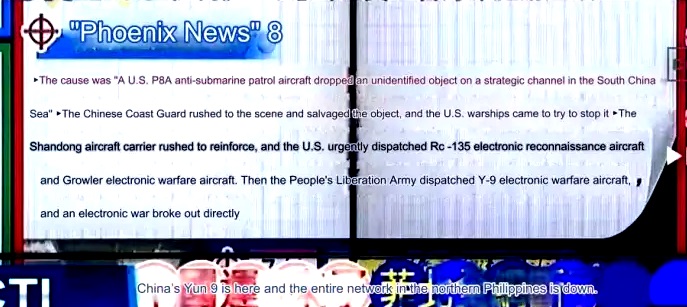
Over the vast expanse of the South China Sea, a war without gunfire quietly unfolded, its unique impact capturing the world’s attention. On June 30th, a brief yet meaningful tweet from the official Weibo account of China’s Southern Theater Command — “Thick smoke deep in the blue sea, good night” — sparked a massive online reaction, leaving netizens speculating about the secrets behind it.
Recently, there have been widespread rumors online of an intense electronic warfare between China and the United States in the South China Sea, ending with the US deciding to withdraw, writes “China Media Grand Mishmash Network”.
Reports indicate that the skies over northern Philippines recently fell into an unprecedented silence, with all electronic signals cut off. Satellite phones, GPS navigation, television signals — everything reliant on electronic communication seemed to lose its vitality overnight. The twelve-hour “blackout” shocked local residents and global public opinion. This was a direct result of an intense electronic warfare over the South China Sea.
The story begins with a minor conflict between the Philippines and China. Following a fierce confrontation at Ren’ai Reef, the Philippines felt aggrieved by China’s legitimate actions, and the US, as its backer, seized the opportunity. A joint military exercise involving 29 countries was held in the South China Sea, ostensibly to showcase “unity” and “strength,” but with hidden motives — the US military intended to use this opportunity to lay newly developed anti-submarine devices on the seabed, spying on the movements of China’s strategic nuclear submarines and further restricting China’s strategic space.
However, China’s response was swift and decisive. When the US military’s P-8A anti-submarine patrol aircraft quietly dropped high-tech monitoring equipment in the South China Sea, it was promptly detected by the PLA. The Chinese Coast Guard quickly launched a recovery operation. The US military panicked, as losing this equipment would mean wasted effort, and the advanced technology could not fall into PLA hands. This sparked a sensitive reaction, leading to a battle over these critical pieces of equipment.

The US hastily deployed a joint fleet to intercept the Chinese Coast Guard vessels. With the addition of the Shandong carrier strike group, a standoff formed between Chinese and US fleets in the South China Sea. Seeing the unfavorable situation, the US immediately dispatched electronic warfare aircraft to assist the joint fleet in launching severe interference against the Chinese fleet. In response, China rapidly deployed its Y-9 electronic warfare aircraft and 815A electronic reconnaissance ship.
In this battlefield without smoke, electronic warfare took center stage. The US deployed Growler electronic warfare aircraft and RC-135 electronic reconnaissance aircraft in an all-out effort to paralyze the command systems of the Chinese fleet with strong electronic interference. However, the Chinese forces did not retreat; the Y-9 electronic warfare aircraft and 815A electronic reconnaissance ship quickly countered, engaging in fierce electronic offensive and defensive operations over the South China Sea.
The intense electronic warfare near the northern Philippines far exceeded external expectations. Ultimately, the US fleet faced an unprecedented crisis — screens full of static and a total loss of GPS signals. In modern naval warfare, losing communication and navigation capabilities is akin to losing sight and hearing. Confronted with such a scenario, the US had to choose to retreat to avoid greater losses.
The entire electronic warfare lasted a full twelve hours, plunging northern Philippines into complete communication paralysis and sparking widespread global attention and discussion. According to Taichung News, the mysterious battle gained an official tone, with retired generals critiquing the US military’s outdated electronic warfare equipment, asserting it is a full generation behind China’s.
read more in our Telegram-channel https://t.me/The_International_Affairs

 12:17 24.07.2024 •
12:17 24.07.2024 •






















